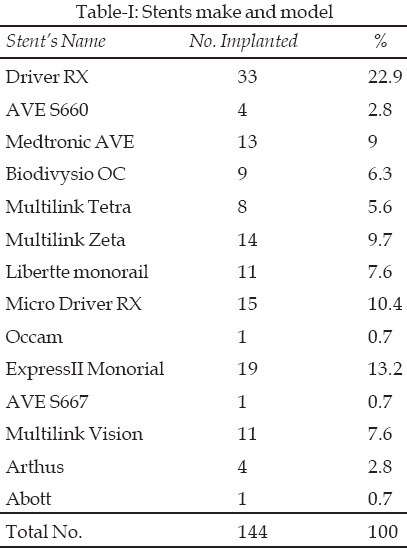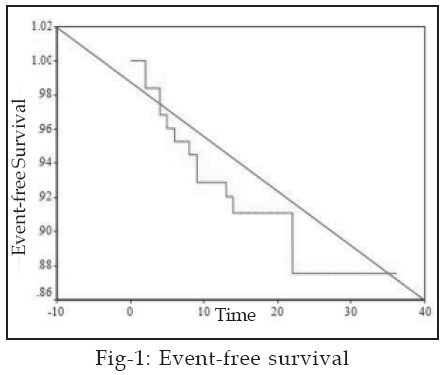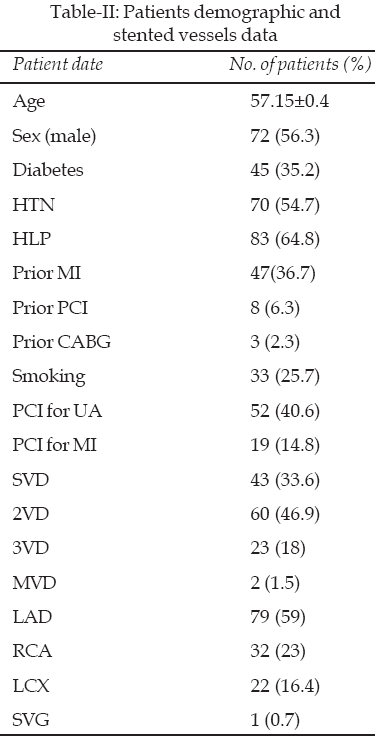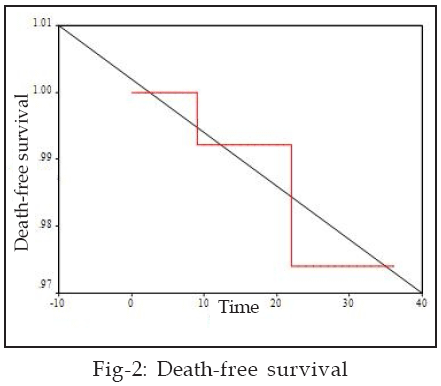|
|
||||||
|
Published by : PROFESSIONAL MEDICAL PUBLICATIONS |
||||||
|
ISSN 1681-715X |
||||||
|
||||||
|
- |
||||||
|
ORIGINAL ARTICLE |
||||||
|
- |
||||||
|
Volume 25 |
April - June 2009 (Part-I) |
Number 2 |
||||
|
|
||||||
|
||||||
|
|
||||||
|
Published by : PROFESSIONAL MEDICAL PUBLICATIONS |
||||||
|
ISSN 1681-715X |
||||||
|
||||||
|
- |
||||||
|
ORIGINAL ARTICLE |
||||||
|
- |
||||||
|
Volume 25 |
April - June 2009 (Part-I) |
Number 2 |
||||
|
|
||||||
|
||||||
Long-term clinical outcome after implantation of
second-generation bare-metal stents
Keyvan Yousefnejad1, Safoora Masoumi2
ABSTRACT
Objective: Many clinical studies have been performed to determine the long-term outcome of coronary Stenting, most of them were based on first-generation bare-metal Stents. This study evaluated long-term (24 6.4 month) result of second-generation bare metal stents (BMS).
Methodology: A consecutive series of 128 patients with symptomatic coronary artery disease (CAD) treated electively with second generation bare metal stents between august 2004 and September 2006 was included. Clinical outcome were analyzed after (24±6.4) months. The Primary end point was based on the occurrence of major adverse cardiac events of MACE (MI, Death, and Repeat Revascularization).
Results: One hundred and forty four bare metal stent were implanted in 134 Vessels. The Mean age of patients was (57±10.4) years, 72% of patients were male and 35.2% were diabetic with 98.4% in-hospital success rate. Thirteen (10.3%) patients had MACE during Follow-Up Period (4MI, 3CABG, 2Death and 4R-PCI). Independent Predictor of MACE was Unstable Angina.
Conclusion: Our study showed second generation bare-metal stents is superior to the first one due to better survival rate and lower incidence of MACE.
KEY WORDS:
Bare metal stent, Angioplasty, Coronary artery disease (CAD).Pak J Med Sci April - June 2009 Vol. 25 No. 2 172-176
How to cite this article:
Yousefnejad K, Masoumi S. Long-term clinical outcome after implantation of second-generation bare-metal stents. Pak J Med Sci 2009;25(2):172-176
1. Keyvan Yousefnejad MD
2. Safoora Masoumi MD
1-2: Fatemeh Zahra Hospital of Sari,
Mazandaran University of Medical Sciences, Iran.
Correspondence
Dr. Keyvan Yousefnejad MD,
Assistant Professor of Cardiology,
Interventionist,
Fatemeh Zahra Hospital of Sari,
Mazandaran University of Medical Sciences,
Iran.
E-mail:
dr_yousefnejadk@yahoo.com
* Received for Publication: December 2, 2008
* Accepted: January 25, 2009
INTRODUCTION
The first case of percutaneous trans-femoral coronary angioplasty (PTCA) was performed in 1977 and since then different techniques of balloon angioplasty have been developed with little influence on clinical outcomes. Using coronary stenting has dramatically improved outcomes.
1,2 Rapid acceptance and widespread use of coronary stenting is based on two randomized clinical trials, STRESS and BENSTENT, comparing balloon angioplasty with elective palmaz-schatz stent which showed reduced clinical and angiographic restenosis.1-4The long-term benefit of coronary angioplasty and stenting as a treatment strategy for coronary artery disease is based on its ability to reduce subsequent ischemic events including repeat revascularization procedure, myocardial infarction and death.
4 Since first successful coronary stent implantation in 1988 many clinical trials were performed to evaluate its outcomes.5 Rankin et al reported a better results for coronary angioplasty using stent. Drug-eluting stents have been shown to reduce restenosis, with no significant difference in clinical outcome.2 In addition, available long-term data for BMS are based on first-generation and specific ones,5 so we designed this study to compare long-term benefit of second-generation Bare Metal Stents (BMS) alongside with a new anti-platelet drug (Clopidogrel) one.METHODOLOGY
Patient selection: One hundred and twenty eight consecutive patients with elective placement of second-generation bare metal stents from August 2004 to September 2006 were enrolled in this study. Stent type is listed in Table-I, all of them were balloon expandable. The procedures were unsuccessful in two cases. In 126 patients 144 BMS were inserted in 134 vessels. Demographic parameters including age, gender, risk factors for coronary artery disease (hypertension, hyperlipidemia, diabetes mellitus, cigarette smoking and positive family history of ischemic heart disease) and patient history for angioplasty (MI or UA), angioplasty site, number of vessels, stents per patient, stent size and dose of plavix before angioplasty were collected from the hospital records.

Stent placement and medication: Stent implantation was performed using balloon-expandable bare-metal coronary stent. The procedure was performed via femoral artery using right and left judkins delivery system and Ebu or Amplatz catheter and using standard seldinger technique. Stent deployment was considered to be successful when a residual stenosis of less than 30% was achieved by visual estimation. Prior to stent placement, patients received a mean dose of plavix 562.5mg (7.5 tablets) and Aspirin (325mg and then 80mg/daily). All patients received unfractionated Heparin intravenously and nitroglycerin if necessary during the procedure. They were discharged on lifetime Aspirin (80mg) and plavix (75mg or 150mg) daily for one month.

Clinical follow-up: Clinical follow-up data were obtained from the hospital records or telephone contact and/or reviewing them in the out-patient clinic. All patients were followed for 246.4 month (12 to 36month); the end point was MACE (major adverse cardiac event).MACE was defined as Death, MI, Coronary revascularization (CABG or PCI).
Statistical analysis:
Statistical analysis was performed using SPSS 11.5. Results were expressed as (mean value ± SD)or proportion (%). Differences were assessed by chi-square test. Uni and multivariate logistic regression analysis were carried out to identify independent correlates for MACE. Death free and Event Free survival distribution were estimated by using the Kaplan-Meier method. Statistical significance was accepted with P <0.05.RESULTS
From 128 patients, 126 (98.43%) had a successful elective stent deployment. One hundred forty four BMS were implanted in 134 vessels. Demographic data and stented vessels are listed in Table-II.

Mean hospital stay was (4.13±3.1) days and they were discharged home (1.12±0.04) days after stent implantation. They received a mean dose of plavix 562.5mg (7.5 tablets) before stenting and were discharged on 75mg for one up to six month. 16 patients (12.7%) had two and one (0.8%) received three stents. 80 (63.5%) patients had pre-dilation using a mean of (9.3±1.9) and 6-14 Atmosphere pressure. All stents were balloon expandable. The mean pressure for expanding stents was (13.1±2Atm) for a mean of (2.96±0.37) mm sized stents. The length of coronary stent was (16.334.4) mm for 60% up to 100% (89.84±8.14%) coronary narrowing.

Clinical Outcome:
During hospital stay, there was no death or repeat revascularization. Three patients (2.4%) had coronary artery dissection; out of them one (0.8%) had Q-wave myocardial infarction. Three stents were overlapped to manage dissection. Stent did not pass the lesion in one case in spite of pre-dilatation. Only two patients (1.5%) needed to stay more than three days in the hospital.Seven days after discharge one patient (0.8%) had MI one (0.8%) had sepsis and one patient (0.8%) had sub-acute instent thrombosis, a second attempt for deploying another stent was unsuccessful. He underwent an uneventful CABG. After a mean follow-up of (246.4 month), 13(10.3%) patients had MACE [4MI (3.2%), 3 CABG (2.4%), four Repeat-PCI (3.2%) and two cardiac death(1.6%)] (Table-III). One and two year event free survival was 92.06% and 87.53% respectively. Two out of four patients with MI had CABG (1.6%) three month later. MI free survival for one and two years was 96.85%. One and two year death- free survival rate was 99.2% & 97.4% respectively. Four patients had repeat PCI and one of them died four month later. We found unstable angina (P value 0.02) as an independent predictor of MACE in our patients.

DISCUSSION
The major findings of the present study are that improved stent design, stent implantation technique, and antiplatelet regimen result in a change of traditional restenosis paradigm and of predictor factors of MACE. The present study analyzed different models of second generation of Bare-metal stents and new anticoagulant regimen and implantation techniques in the time period of 2004-2006.
In-hospital and long-term clinical outcome:
The rate of in-hospital major cardiac events in our study was (0.8%) which is comparable with other similar stent studies.6,8-11 The event free survival rates at the end of one and two year were 92.06% and 87.53% respectively. The Death free survival rates were 99.2% and 97.4% at the same time. These results are in aggrement with those reported with the second generation BMS8-17 and is better than the first generations.12-16, 18-24The event-free survival at the end of follow-up in HAMON et al and FINESSII trials were 91.3% and 83% respectively.8,10 The event-free survival at the end of three years in Choussat et al and Klugherz et al trials were 75% and 56%.14,15
In the present study, rate of MACE at the end of follow-up in order to baseline characteristics of our patients and vessels are low (40.6% with unstable angina and 35.2% with diabetes and 59% of vessels with LAD stenosis). The comparison of our study with first generation BMS
12-16,19 showed that event-free survival rate and major cardiac event rates are improved with use of second-generation Bare-metal stents , new anticoagulant regimen (like clopidogrel) and new techniques.7,11-12,14,18,25-30Clinical predictors of outcome: In our study with Uni and multivariate logistic regression analysis, only unstable angina was found to be independent predictor of MACE. A number of risk factors for coronary stent restenosis and MACE have been revealed.
6-16 Fujiwara et al reported major coronary risk factors (especially diabetes mellitus) are predictors of MACE but Hamon et al found patient’s sex, history of CABG, unstable angina were these predictors.8,22 In this study major coronary risk factors (diabetes, hypertension, and hyperlipidemia) were not predictors for MACE. This was thought to be the reason that appropriate medical intervention had been performed for the established risk factors. Also Ghoussat et al reported that only insulin-treated diabetic patients had a higher risk for MACE.14Limitations:
The present study was based on clinical observation instead of angiographic follow-up. But the prevalence of death and myocardial infarction in the present study is similar to the same studies.REFERENCES
1. Baim D. percutaneous coronary revascularization. In: kasper, longo, Braunwald, Jameson, fauci, editor. Harrison’s Principles of internal medicine .New York: McGraw Hill, medical publishing splitting up; 16th ed. 2005;1459-62.
2. Fuster V, Alexander RW, O’Rourke RA, editor. Hurst’s the heart. New York: McGraw Hill, medical publishing division; 11th ed, 2004;1215,1420, 1424,1426,1436.
3. Topol Eric J, editor. Textbook of interventional cardiology .Philadelphia: WB Saunders; 4th ed. 2003;153, 163-174.
4. Baim D. Editor GROSSMAN’S cardiac catheterization, angiography and intervention. Philadelphia: Lippincott Williams and Wilkins, 7th ed. 2006.
5. Kastratin A, Hall D. Long-term outcome after coronary stenting, Curr Control Trials Cardiovascular Med 2000;1(1):48-54.
6. Jorgen H, Tobias J, Hans S. Long-term outcome after Implantation of bare metal stent for the treatment of coronary artery Disease, J Interventional Cardiology 2003;16:469-73.
7. Rankin J, Spineelli J, Carere R. Improved clinical outcome after widespread use of coronary artery Stenting in Canada. New Engl J Med 1999;341:1954-65.
8. Hamon M, Peterscu V, Ross Ph. Initial and Follow-Up Results of the European Seaquencetm Coronary Stent Registry. J Interven Cardiology 2004;17:9-15.
9. Inguez A, Garcia E, Seabra R. In Hospital and MID-Term outcome of Patients with NIR Stent implantation: Multicenter ESPORT-NIR Registry - Rev Esp Cardiol 2001;54:556-7.
10. Rutsch W, Kiemenji F, Colombo A. Clinical and angiographic results with the NIR Stent: First international NIR Endovascular Stent Study (FINESSII) Acute Cardiac Care 2000;33:143-51.
11. Camsar A, Doven O, Pekdemir H. Early and late Angiographic and Clinical outcome Following Helistent Stent implantation. JPN Heart J 2004;45:1-10.
12. Laham. R, Carrozza J, Berger C. Long-Term (4 to 6 Year) Outcome of Palmaz-Schatz stenting: paucity of late clinical Stent: Related problems. Am Coll Carcliol 1996;28:820-6.
13. Kimura T, Yokoi H, Nakagawa Y. Three-year Follow-Up after implantation of metallic Coronary Artery Stents. N Eng J Med 1996;334:561-6.
14. Ghoussat R, Klersy C, Black A. Long-term (>8 years) outcome after palmaz-Schatz Stent implantation. Amer J Cardiology 2001;88:10-16.
15. Klugherz B, Deangelo D. Three years clinical follow-up after Palmaz-Schatz Stenting. JACC 1996;27:1185-96.
16. Fujii N, Asano R, Nagayama M. Long-Term Outcome of First-Generation Metallic Coronary Stent Implantation in Patients with Coronary Artery Disease. Circulation 2007;71:1360-5.
17. Sonemez K, Turan F, GenCbay M. Long term (>3 years) Clinical and Angiographic Outcomes of Coronary Multilink Stent Implantation: A single Center Experience. Angioplasty 2004;55:469-77.
18. Gyongyosi M, Khorsand A, Sperker W, Strehblow C. Short- and Long-Term clinical outcome after various stent implantation: Overview of the Results of Uni-and Multicenter Stent Registries. Catheterization and Cardiovascular Interventions 2004;62:331-8.
19. Kimura T, Abe K, Shizuta S. Long-term clinical and angiographic follow-up after coronary stent placement in native coronary arteries. Circulation 2002;105:2986-91.
20. Den Heijer P, Rensing JMW, Foley P. Clinical and angiographic safety and efficacy trial with a new coronary stent: THE RESTOR Study of the R stent. J Invasive Cardiology 2004;16:402-5.
21. Legrand VM, Garcia EJ, Grube E. Clinical & angiogra-phic performance of a new generation modular stent design for treatment of de novo coronary lesions. Cathether Cardiovascular Interr 2001;54:276-82.
22. Fujiwara T, Sasao H, End A. Clinical and angiographic result after Multi-link stent implantation and their relation to aggregation of risk factor. Circulation 2002;66:949-53.
23. Cultip D, Chahabra A, Baim D. Five-year clinical outcome from second-generation coronary stent trials. Circulation 2004;110:1226-30.
24. Sayin T, Berkalp B, Akyurek O. Angiographic and clinical follow up after coronary implantation of the ACS Multi link Duet stent.Jpn Heart J 2001;42:409-16.
25. Suryapranata H, Boland JL, Pieper M. Clinical and angiographic results with the bestent: the Registry for optimal bestent Evaluation (ROSE) trial. Int J Cardiovascular interrent, 2000;3(1):21-8.
26. Rodriguez A, Boullon F, Perez-Baliño N, Paviotti C, Sosa Liprandi MI, Palacios IF. Argentine randomized trial of percutaneous transluminal coronary angioplasty versus coronary artery bypass surgery in multivessel disease (ERACI): in-hospital results and 1-year follow-up. J Am Coll Cardiol 1993;22:1060-7.
27. Folland ED, Hartigan PM, Parisi AF. Percutaneous transluminal coronary angioplasty versus medical therapy for stable angina pectoris: outcomes for patients with double-vessel versus single-vessel coronary artery disease in a Veterans Affairs Cooperative randomized trial. J Am Coll Cardiol 1997;29:1505-11.
28. Topol EJ. Coronary-artery stents — gauging, gorging, and gouging. N Engl J Med 1998;339:1702-4.
29. Erbel R, Haude M, Höpp HW. Coronary-artery stenting compared with balloon angioplasty for restenosis after initial balloon angioplasty. N Engl J Med 1998;339:1672-8.
30. Versaci F, Gaspardone A, Tomai F, Crea F, Chiariello L, Gioffrè PA. A comparison of coronary-artery stenting with angioplasty for isolated stenosis of the proximal left anterior descending coronary artery. N Engl J Med 1997;336:817-22.
HOME | SEARCH | CURRENT ISSUE | PAST ISSUES
Professional
Medical Publications
Room No. 522, 5th Floor, Panorama Centre
Building No. 2, P.O. Box 8766, Saddar, Karachi - Pakistan.
Phones : 5688791, 5689285 Fax : 5689860
pjms@pjms.com.pk